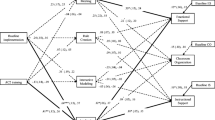Abstract
The ecological validity of interventions can be enhanced when we first consider the environment in which our students participate. Antecedent interventions such as environmental manipulations can be easily and effectively implemented to enhance student engagement and decrease challenging behaviors in classrooms. The current study explored the use of a measurement system developed for widespread use within a school for students with autism spectrum disorder that helped to inform a classroom-wide environmental manipulation in the form of classroom arrangements. Baseline data across three classrooms suggested high, variable rates of challenging behavior and low rates of engagement with staff and materials. After the introduction of the antecedent intervention, engagement increased and challenging behavior decreased. Helping practitioners develop environmental and systems changes may help to complement individual behavior intervention plans.


Similar content being viewed by others
References
Bicard, D. F., Ervin, A., Bicard, S. C., & Baylot-Casey, L. (2012). Differential effects of seating arrangements on disruptive behavior of fifth grade students during independent seatwork. Journal of Applied Behavior Analysis, 45, 407–412. https://doi.org/10.1901/jaba.2012.45-407.
Davis, C. A., & Fox, J. (1999). Evaluating environmental arrangement as setting events: Review and implications for measurement. Journal of Behavioral Education, 9(2), 77–96.
Doke, L. A., & Risley, T. R. (1972). The Organization of day-care environments: Required vs. optimal activities, Journal of Applied Behavior Analysis, 5(4), 405–420.
Kennedy, C. H., & Itkonen, T. (1993). Effects of setting events on the problem behavior of students with disabilities. Journal of Applied Behavior Analysis, 26, 321–327.
Melin, L., & Gotestam, K. G. (1981). The effects of rearranging ward routines on communication and eating behaviors of psychogeriatric patients. Journal of Applied Behavior Analysis, 14(1), 47–51.
Perry, A., Cummings, A., Dunn Geier, J., Freeman, N., Hughes, S., LaRose, L., et al. (2008). Effectiveness of intensive behavioral intervention in a large, community-based program. Research in Autism Spectrum Disorders, 2, 621–642.
Rosenfield, P., Lambert, N. M., & Black, A. (1985). Desk arrangement effects on pupil classroom behavior. Journal of Educational Psychology, 77, 101–108.
Schmidt, R. E. (1987). Effects of two classroom seating arrangements on classroom participation and academic responding with Native American junior high school students. Techniques, 3(3), 172–180.
Sulzer-Azaroff, B., & Mayer, G. R. (1991). Behavior analysis for lasting change. Belmont, CA: Wadsworth/Thomson Learning.
Tingstrom, D. H., Sterling-Turner, H. E., & Wilczynski, S. M. (2006). The good behavior game: 1969–2002. Behavior Modification, 30, 225–253. https://doi.org/10.1177/0145445503261165.
Twardosz, S., Cataldo, M. F., & Risley, T. R. (1974). Open environment design for infant and toddler day care. Journal of Applied Behavior Analysis, 7(4), 529–546.
Wannarka, R., & Ruhl, K. (2008). Seating arrangements that promote positive academic and behavioural outcomes: A review of empirical research. Support for Learning, 23, 89–93.
Author Note
James W. Jackson is now at Kinark Child and Family Services, Ontario, Canada; Sarah M. Dunkel-Jackson is now at Seneca College, Ontario, Canada;
The authors would like to thank Jacquelyn MacDonald for her assistance with data collection.
Funding
No external funding was utilized for completion of this research.
Author information
Authors and Affiliations
Corresponding author
Ethics declarations
Ethical Approval
All procedures performed in this study that involved human participants were in accordance with the ethical standards of the institutional and/or national research committee and with the 1964 Helsinki declaration and its later amendments or comparable ethical standards.
Informed Consent
Informed consent was obtained for participation in this research.
Additional information
Publisher's Note
Springer Nature remains neutral with regard to jurisdictional claims in published maps and institutional affiliations.
Publisher’s note
Springer Nature remains neutral with regard to jurisdictional claims in published maps and institutional affiliations.
Rights and permissions
About this article
Cite this article
Jackson, J.W., Dunkel-Jackson, S.M., Dixon, M.R. et al. Effectiveness of Environmental Manipulation to Enhance Engagement and Ecological Validity at an Agency Serving Individuals With Autism Spectrum Disorder and Other Disabilities. Behav Analysis Practice 15, 1390–1395 (2022). https://doi.org/10.1007/s40617-019-00392-z
Published:
Issue Date:
DOI: https://doi.org/10.1007/s40617-019-00392-z



